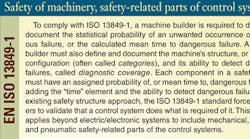Machine builders who sell internationally (or who are looking to gain a competitive edge) should consider the following: The European Union standards bodies (CEN and CENELEC) have mandated two of the world's most rigorous machine safety standards: the International Organization for Standardization (ISO 13849-1) and the International Electrotechnical Commission (IEC 62061). Any machine shipped into or out of Europe must comply with one of these two standards after the final withdrawal of EN 954-1 at the end of 2011.
Manufacturers demand compliance
Manufacturers (particularly those selling globally) are seeking machine builders who can design machines in compliance with these international standards. In some cases, it's mandated in order to manufacture in certain countries. Standardization is also being spurred by increased efforts to streamline plants globally. In short, upfront investments in this arena help protect workers, reduce safety incidents, minimize training and maintenance costs, and often increase productivity.
New elements of time and risk help justify costs
What's different about these new directives? Historically, machine control safety standards were prescriptive in nature, simply providing guidance on control-system structure to help ensure safety requirements were met. The newer international safety system standards are more rigorous in their design requirements and provide a more quantifiable methodology to help ensure overall safety system performance and integrity.
More specifically, the international standards address time and risk — two elements critical to maintaining the reliability of a machine's safety functions.
The EN ISO 13849-1 and EN/IEC 62061 standards require machine builders to identify and document the potential hazards associated with a machine and the risk levels the hazards present to users. The safety system is then designed to the level of risk associated with the hazards present on the machine. This allows the engineer to design the safety system to the correct functional level. Appropriate documentation proves a machine's level of safety; designers can better justify a safety system upgrade; and operators can be more confident in the reliability of a machine's safety system.
Previously, a designer may have had difficulty understanding or explaining why a costly or seemingly sophisticated safety system was needed for a particular application. Now, with the ability to quantify circuit reliability through specific performance and system-integrity calculations, the designer can demonstrate value in terms of actual risk reduction — to more easily justify the value of safety. Furthermore, machine designers can leverage required documentation to cost-justify a system upgrade that includes more effective safety.
Finally, because the standards are designed to assess risk over prolonged periods, a machine's long-term safety can be more predictable, which enhances machine operator confidence while operating a machine, in turn helping to boost protection and productivity on the job.
For more information on EN ISO 13849-1 and EN/IEC 62061, refer to “New Machine Safety Standards Usher in Era of Better Design Flexibility,” on Rockwell Automation's Safety Resource Center — at discover.rockwellautomation.com/EN_Safety_Solutions.aspx. This free site also includes resources on machine and process safety, services, legislation, and standards.


